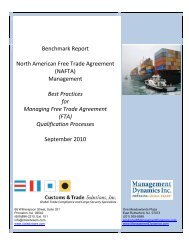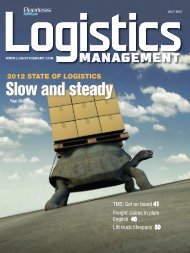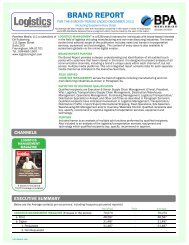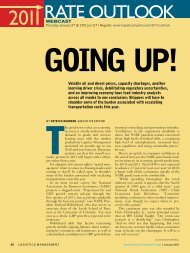Logistics Management - June 2010
Logistics Management - June 2010
Logistics Management - June 2010
Create successful ePaper yourself
Turn your PDF publications into a flip-book with our unique Google optimized e-Paper software.
TRUCKLOAD<br />
Special Report<br />
There are solid indications that the<br />
days of excess supply are over. According<br />
to an analysis of rates and interviews<br />
with analysts and leading TL<br />
executives, all signs point to a revival<br />
of truckload rates due to rising costs,<br />
tighter capacity, increased regulation,<br />
and the overall economic recovery in<br />
the industrial and retail sectors.<br />
“We’re in a state of flux right now,”<br />
says John G. Larkin, longtime trucking<br />
analyst with financial analyst firm<br />
Stifel Nicolaus. “Most contract TL<br />
rates are presently being negotiated<br />
down another 5 percent to 6 percent<br />
on top of the major rate decreases negotiated<br />
over the past several years,” he<br />
says. These rates will be in place until<br />
contracts come due next year or until<br />
shippers start to run out of capacity.<br />
“Our sense is that shippers will not<br />
run out of capacity over the remainder<br />
of <strong>2010</strong> as the recovery will be tepid<br />
at best,” Larkin adds, noting that U.S.<br />
unemployment remains stubbornly<br />
high and American businesses are<br />
reticent to add more workers or make<br />
large capital expenditures not knowing<br />
whether incremental anti-business legislation<br />
will be enacted by Congress.<br />
“But assuming a moderate recovery<br />
from here, pricing power should<br />
start to return to the carriers in a<br />
bigger way come 2011, especially if incremental capacity<br />
exits the industry between now and then,” Larkin predicts.<br />
Unfortunately for carriers, incremental costs may offset<br />
much of those 2011 rate increases. Those cost increases<br />
are likely to include higher driver pay, higher fuel costs,<br />
and higher equipment ownership costs. While contract<br />
rates look like a bargain for shippers now, with the exception<br />
of some expedited carriers and flatbed carriers, spot<br />
pricing has consistently been improving over the past<br />
several quarters.<br />
Spot TL rates were “often below variable cost a year ago,<br />
but that is no longer the case,” Larkin says. Contract rates<br />
usually follow any rise in spot market rates, he adds.<br />
William Greene, trucking analyst with Morgan Stanley,<br />
says that while overall TL fundamentals are improving,<br />
trucking rates may not rise substantially until 2011. He’s<br />
predicting “low- to mid-single digit TL pricing increases”<br />
by year-end.<br />
“We saw capacity come back in<br />
February and March that we’re<br />
really not used to seeing. In the<br />
last three weeks of April, we<br />
saw rate increases coming.”<br />
The big carriers’ view<br />
Truckload is the most fragmented<br />
sector of the trucking industry with<br />
even the largest carriers such as<br />
Swift Transportation and Schneider<br />
National barely holding 1 percent<br />
market share. While the mega-carriers<br />
have some economies of scale, thousands<br />
of smaller niche TL players can<br />
at times offer identical services at bargain<br />
rates because of lower overhead<br />
costs and other innovations.<br />
TL has also historically been<br />
trucking’s most responsive sector.<br />
Because nearly all the top players are<br />
non-union, they can take capacity out<br />
quickly in any economic downturn—<br />
and most did. Larkin estimated as<br />
much as 15 percent of over-the-road<br />
TL capacity left the industry during<br />
the 2006-2009 trucking recession and<br />
has not fully returned yet.<br />
Quinn of U.S. Xpress adds that<br />
he’s definitely seen an increase in<br />
economic activity, but that it’s<br />
“difficult to tell how sustainable it<br />
will be.” That’s because it’s unclear<br />
whether the recent rise in industrial<br />
demand—the U.S. manufacturing<br />
index rose 0.9 percent in March, the<br />
latest in a string of monthly increases—is<br />
a sure sign of a solid economic<br />
recovery or merely a restocking of<br />
inventory from a very depressed basis.<br />
“But it’s better than it was a year ago at this time,”<br />
Quinn says. “Definitely, from the economic indicators,<br />
there is a pickup in economic activity.”<br />
Most years, trucking activity starts building in March<br />
through the second and third quarters to a peak period from<br />
August through November. Though nobody is certain, many<br />
analysts are suggesting that <strong>2010</strong> could be one of those “classic”<br />
years that follows that pattern. Already, some TL carriers<br />
are reporting impressive rate increases in the spot market, if<br />
not in their contract rates just yet.<br />
“We have seen some spot market opportunities,” Quinn<br />
reports. “Our volumes were decent in April. That’s going to<br />
lend itself to some pricing power if it continues. As we get<br />
into peak shipping months, there could be some shortages of<br />
equipment.”<br />
That’s because of what Quinn describes as a “substantial<br />
erosion” of truckload capacity during the recession. That<br />
— James Bozeman,<br />
president and CEO of<br />
J.M. Bozeman Enterprises<br />
62S <strong>June</strong> <strong>2010</strong> • <strong>Logistics</strong> <strong>Management</strong>

















